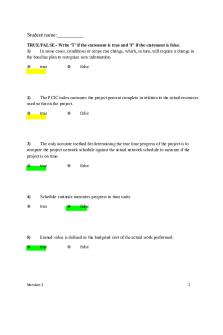Pharmacology Test 1 Version 1 PDF

| Title | Pharmacology Test 1 Version 1 |
|---|---|
| Author | Malina Kaelani Hill |
| Course | nursing |
| Institution | American Career College |
| Pages | 2 |
| File Size | 58.1 KB |
| File Type | |
| Total Downloads | 84 |
| Total Views | 152 |
Summary
Download Pharmacology Test 1 Version 1 PDF
Description
Pharmacology Test 1 Version 1 Objective data- information that is observed or measured by someone other than the patient. Obtained through observation. Subjective data- information not measurable. Obtained through questioning When would you withhold a medication- if there is a problem or suspected problem with the medication order Nine rights of drug administration- right patient, route, dose, time, document, reason, drug, response, right to refuse Drugs that need to be given exactly on schedule- to be effective, many drugs must be given exactly on schedule, day and night to keep the level of drugs constant in the body What action is needed for High Alert Drugs- they are packed and stored differently and given differently than other drugs because they have a high risk for harm when associated with drug errors Adverse effect, side effects what is the difference- adverse effects severe and require medical intervention. Side effects are usually mild and require no medical interventions Drug diversion- illegal transfer of regulated drugs from patient for whom it was prescribed to another person like a nurse for their own use
Psychological dependence- feeling of anxiety stress or tension when a patient does not have a medication
Narcotic control, wasting, spilling, drawing up, inventorying-always have a witness and always document when dealing with narcotics Single drug order- a one-time order to be given at a specified time Standing drug order- a drug order that indicates that the drug is to be given until discontinued or for a certain number of doses STAT drug order- a one-time order to be given immediately Generic drug name- the most common drug name used by the manufacturer in all countries. Aka nonproprietary name Trade drug name-the proprietary name that a manufacturer gives to a specific drug. Aka brand name Drug receptor sites how they work- small “lock-like” areas of cell membranes that control what substances either enter the cell or change their activity
Antagonist- drugs that attach at a drug receptor site but do not activate or unlock the receptor Agonist- drugs that work by activating or unlocking cell receptors causing the same actions as the body’s own chemicals DiffusionOsmosis Filtration Solubility Grapefruit juice and medications Half-life of medication Probenecid and penicillin
What steps are done before giving a medication (safety) Drug history what is collected Steps taken to prevent drug errors Regulation for narcotic control system...
Similar Free PDFs

Pharmacology Test 1 Version 1
- 2 Pages

Pharmacology exam 1 - Test
- 226 Pages

Test Pharmacology UTM Test 1 - 2012
- 11 Pages

Test version 1 Fall 2017, questions
- 20 Pages

Chapter 03 Test Bank version 1
- 53 Pages

Chapter 14 Test Bank version 1
- 27 Pages

Chapter 01 Test Bank version 1
- 86 Pages

MAC1114 Review Test 1 Version A
- 10 Pages

Chapter 14 Test Bank version 1
- 40 Pages

chem 2015 test 2 version 1
- 20 Pages

MAC1114 Review Test 1 Version B
- 9 Pages

Chapter 15 Test Bank version 1
- 37 Pages

Chapter 02 Test Bank version 1
- 45 Pages

Chapter 01 Test Bank version 1
- 246 Pages

Chapter 13 Test Bank version 1
- 37 Pages
Popular Institutions
- Tinajero National High School - Annex
- Politeknik Caltex Riau
- Yokohama City University
- SGT University
- University of Al-Qadisiyah
- Divine Word College of Vigan
- Techniek College Rotterdam
- Universidade de Santiago
- Universiti Teknologi MARA Cawangan Johor Kampus Pasir Gudang
- Poltekkes Kemenkes Yogyakarta
- Baguio City National High School
- Colegio san marcos
- preparatoria uno
- Centro de Bachillerato Tecnológico Industrial y de Servicios No. 107
- Dalian Maritime University
- Quang Trung Secondary School
- Colegio Tecnológico en Informática
- Corporación Regional de Educación Superior
- Grupo CEDVA
- Dar Al Uloom University
- Centro de Estudios Preuniversitarios de la Universidad Nacional de Ingeniería
- 上智大学
- Aakash International School, Nuna Majara
- San Felipe Neri Catholic School
- Kang Chiao International School - New Taipei City
- Misamis Occidental National High School
- Institución Educativa Escuela Normal Juan Ladrilleros
- Kolehiyo ng Pantukan
- Batanes State College
- Instituto Continental
- Sekolah Menengah Kejuruan Kesehatan Kaltara (Tarakan)
- Colegio de La Inmaculada Concepcion - Cebu
